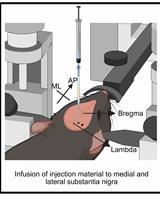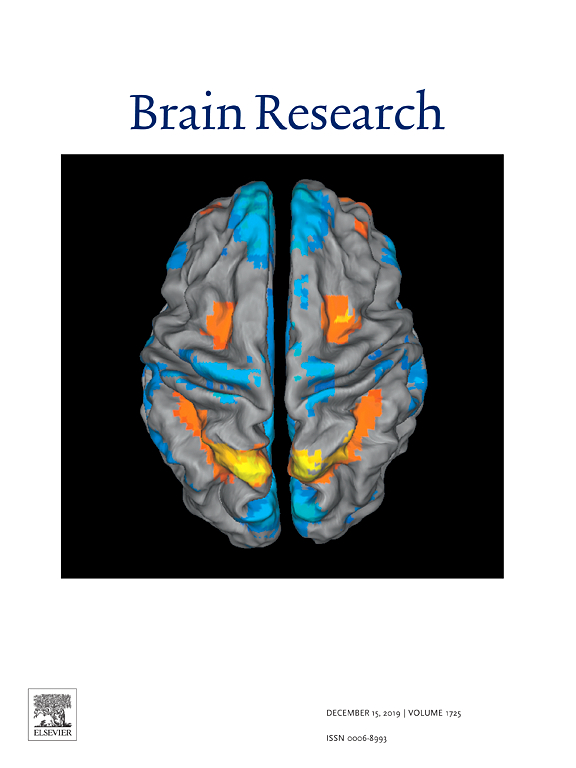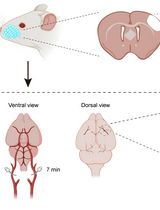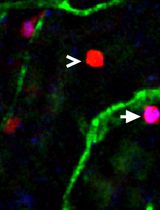- EN - English
- CN - 中文
Intra-arterial Drug Delivery to the Ischemic Brain in Rat Middle Cerebral Artery Occlusion Model
大鼠中脑动脉闭塞模型中的动脉内脑缺血给药
发布: 2019年12月05日第9卷第23期 DOI: 10.21769/BioProtoc.3438 浏览次数: 6901
评审: Geoffrey C. Y. LauAnonymous reviewer(s)

相关实验方案

基于 rAAV-α-Syn 与 α-Syn 预成纤维共同构建的帕金森病一体化小鼠模型
Santhosh Kumar Subramanya [...] Poonam Thakur
2025年12月05日 1395 阅读
Abstract
Rat transient middle cerebral artery occlusion (tMCAO) model is one of the most commonly used animal models in ischemic stroke studies. In the model, increasing safety and efficacy of therapeutic agent administration, such as stem cells and drugs directly to the ischemic brain using the internal carotid artery (ICA) is essential, because using the common carotid artery (CCA) for injection can close CCA completely and cause many complications after tMCAO surgery. Also, the pterygopalatine artery (PPA) is an arterial branch of the ICA that supplies blood circulation of the external part of the brain and removing the blood circulation of the PPA is required for more complete induction of ischemia to the brain. Herein, we present the insertion of intra-arterial catheter in the ICA via the external carotid artery (ECA) after the PPA in rats subjected to tMCAO surgery.
Keywords: Drug delivery (给药)Background
Rat ischemic stroke models have been used substantially to evaluate the benefit of therapeutic agents and stem cells and to study the underlying mechanisms (Rousselet et al., 2012; Azedi et al., 2017). Since ischemic stroke in patients is mostly caused by the occlusion of the middle cerebral artery (MCA), intraluminal suture middle cerebral artery occlusion (MCAO) has become the most commonly used models in the investigation of stroke in rodents such as rat and mice (Longa et al., 1989; Wang-Fischer, 2008; Tajiri et al., 2013; Fluri et al., 2015).
Method of intra-arterial delivery in stroke treatment is used in various studies and shows high safety and efficacy (Cloft et al., 2009; Chua et al., 2011; Crumrine et al., 2011; Azedi et al., 2019). In fact, Stem cells or drugs can be injected into the internal carotid artery (ICA) via common carotid artery (CCA) for targeted delivery into the reperfused brain tissue (Li et al., 2010; Misra et al., 2012; Du et al., 2014). However, after cutting the CCA for any interventions or injections, it has to be closed completely; or many complications for the animal, like increasing the mortality rate, can occur. Also, because the pterygopalatine artery (PPA) is a branch of the ICA, blood or any drug solutions will shunt into the PPA supplied region during any injection to the ICA and the efficacy of treatment may be reduced. Therefore, most researchers occluded the PPA when they performed intra-arterial injection (Guo et al., 2013); however, because of deep location and poor access to this artery, ligation of the PPA is very hard and often causes complications (Chen et al., 2008). In this protocol, we describe a simple method for intra-arterial injection to the ICA via external carotid artery (ECA) to the ischemic brain without manipulating the PPA after tMCAO surgery. You can see a schematic view of this procedure in Figure 1.

Figure 1. The schematic view of tMCAO surgery and insertion of intra-arterial catheter in ICA. A. The place of cutting in ECA. B. Insertion of microfilament for occluding MCA. C. Insertion of intra-arterial catheter after PPA branch. ACA: Anterior cerebral artery. AchA: Anterior choroid artery. CCA: Common carotid artery. HTA: Hypothalamic artery. ICA: Internal cerebral artery. MCA: Middle cerebral artery. PCOM: Posterior communication artery. PPA: Pterygopalatine artery.
Materials and Reagents
- Cannula–24G x 19 mm x 50 (Terumo, catalog number: SR+DS2419PX)
- Syringe (BD, catalog number: 328411)
- Microfilament with round tip and silicon coating (Doccol, catalog number: 403734PK5Re)
- 4-0 silk suture (Supa, catalog number: S64019B3)
- 3-0 nylon suture (Supa, catalog number: N63026B3)
- Sterile Gauze pad (Safa Teb, catalog number: 1307018)
- Wistar rat (11-week-old)
- Eye cream with vitamin A (Sina Darou, catalog number: 1228039225)
- Ketamine (Rotexmedica, catalog number: 159-85-34830-00)
- Xylazine (Interchemie, catalog number: Rp399)
- Lidocaine 10% (Iran Darou, catalog number: 1228089381)
- 0.25% Bupivacaine (AstraZeneca, catalog number: 0186-1027-01)
- Ampicillin (GC Hanford, catalog number: 10515-946-25)
- Alcohol (Merck, catalog number: 100983.2500)
- Ketamine/xylazine solution (see Recipes)
Equipment
- Balance (Sartorius, catalog number: LP6200S)
- Stereo microscope (ZTX-E zoom, 10x-40x)
- Rodent surgery board (VWR, model: 10718-012)
- Rectal thermometer (Welch Allyn, model: SureTemp Plus 690)
- Vessel clip (Roboz, catalog number: RS-5420)
- Microdissecting spring scissor (Roboz, catalog number: RS-5600)
- Toothless tweezers with straight (Roboz, catalog number: RS-4972)
- Toothless tweezers with curve head (Roboz, catalog number: RS5079)
- Scissors (Roboz, catalog number: RS6762)
- Needle holder (Roboz, catalog number: RS-7860L)
- Tooth head forceps (Roboz, catalog number: RS5112)
- Microdissection retractor (Roboz, catalog number: RS6515)
- Thermal blanket (ALA Scientific, catalog number: HEATINGPAD-1/2)
Procedure
文章信息
版权信息
© 2019 The Authors; exclusive licensee Bio-protocol LLC.
如何引用
Azedi, F., Mehrpour, M., Kazemnejad, S., Mousavizadeh, K., Zarnani, A. H. and Joghataei, M. T. (2019). Intra-arterial Drug Delivery to the Ischemic Brain in Rat Middle Cerebral Artery Occlusion Model. Bio-protocol 9(23): e3438. DOI: 10.21769/BioProtoc.3438.
分类
神经科学 > 神经系统疾病 > 脑卒中
神经科学 > 神经系统疾病 > 动物模型
您对这篇实验方法有问题吗?
在此处发布您的问题,我们将邀请本文作者来回答。同时,我们会将您的问题发布到Bio-protocol Exchange,以便寻求社区成员的帮助。
Share
Bluesky
X
Copy link













